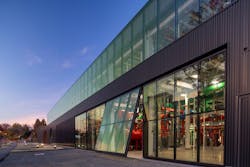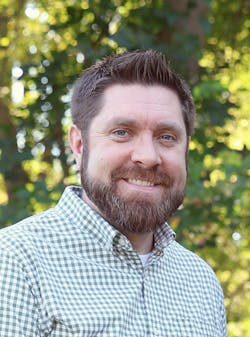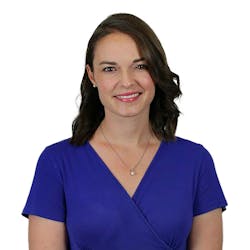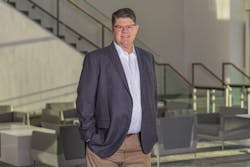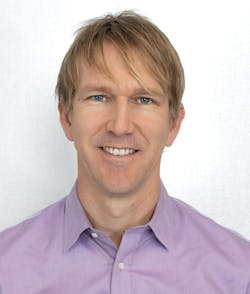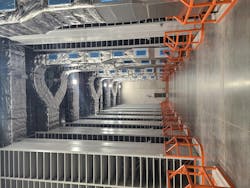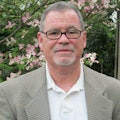A new certification validates decarbonization expertise
In October, members of a design-build team that included Affiliated Engineers, DN Tanks, Lavellee Brensinger Architects, the Arch Energy division of Consigli Construction, and the civil engineer VHB were part of a ribbon-cutting ceremony on the campus of the University of New Hampshire in Durham, for a 1.4-million-gallon thermal energy storage tank that, with an interconnection to an existing plant, allows for a minimum of 10,400 ton-hours of chilled water produced during non-peak hours to be stored and then released as thermal energy during peak-use hours.
The new tank reduces the need for additional energy production, enabling UNH to decrease its dependence on non-renewable sources. Consigli and Arch Energy also helped the university unlock Inflation Reduction Act tax credits.
This is but one of a growing number of projects that are aimed at lowering the built environment’s carbon footprint. As often as not, these projects are responses to municipal mandates and/or longer-range climate commitments to make new and existing buildings more sustainable and carbon freer. The Higher Ed sector has led this movement, but owners of a wider variety of building types are also taking their life-cycle carbon emissions profile seriously by investigating new technologies and building techniques that reduce energy loads and the need for fossil-fueled energy sources.
“A lot of clients are moving toward decarbonization,” says Matthew McReynolds, PE, Mechanical Building Systems Group Leader for NV5 in St. Paul, Minn. McReynolds is one of five engineers at his firm certified by ASHRAE’s Certified Decarbonization Professional (CDP) program, which was initiated and is funded by the ASHRAE Center of Excellence for Building Decarbonization. McReynolds says his firm saw this program as an opportunity “to get in on the ground floor, running.”
The program “is aligned with what we’re doing here” in terms of meeting client demand for decarb solutions, says Brian Johnson, PE, BEMP, HOK’s Energy Modeling Group Leader in San Francisco, who was also among the first group of CPDs.
As of early November, there were 73 CPDs in eight countries. ASHRAE has more than 1,000 testing centers worldwide, and the test is offered year-round. M. Dennis Knight, PE, BEMP, ASHRAE’s President, expects ASHRAE to receive more than 200 applications from AEC professionals by the end of the first 12-month application period on April 30, 2025.
“Certification helps answer questions like, What does ‘carbon free’ actually mean? And how we do that?”
In response to BD+C’s written questions, Knight stated that ASHRAE developed this program to validate competence to assess, analyze, and develop effective and sustainable strategies that reduce or eliminate the life-cycle carbon footprint of new and existing buildings.
The 2½-hour proctored exam that determines certification has 115 multiple-choice questions, of which 100 are scored. Knight elaborated that the questions measure the taker’s ability to perform such tasks as evaluate the carbon impact of design decisions, or leverage BIM tools to optimize operations and maintenance, or recommend electrification strategies for buildings.
The program tests awareness of the “blocking and tackling” that are involved in decarbonization, says Blake Ellis, Principal and Campus and District Energy Manager for Burns & McDonnell in Kansas City, Mo., a CDP who is also Vice Chairman of ASHRAE’s Center of Excellence for Building Decarbonization.
The test fee is $495 for ASHRAE members and $745 for nonmembers. The fee is discounted 55% for applicants who need to re-sit for the test.
Certification bolsters credibility
The seven CDPs whom BD+C interviewed for this article already had extensive industry experience, and had worked on decarbonization projects. So why certify?
Jan Wei, PE, LEED AP, HBDP, BCXP, CBCD, a Principal for Stantec in New York, says his firm lately has been doing a lot of energy reviews for clients, and has worked with municipal building departments on initiatives like New York City’s Local Law 97 that mandates electrification for commercial and residential buildings. Demonstrating compliance, he says, “requires someone who is knowledgeable.” Wei is one of several CPDs at Stantec.
Christina Sanborn, AIA, LEED AP, an architect with Mazzetti in Ohio, has been her firm’s decarb specialist since October 2021. Being a CDP, she says, “lends credibility” to her work, especially with clients for which there is a “big gap in understanding” about how decarbonization technology, such as recovery chillers and heat pumps, works.
“It wasn’t about studying to pass. It tested engineering judgement for best solutions.”
“Certification helps answer questions like what does ‘carbon free’ actually mean, and how we do that,” says NV5’s McReynolds. He adds that the line separating reality and politics for some clients gets blurred without these explanations.
The CDPs interviewed confirm that ASHRAE did not provide much in the way of prep materials prior to administering the test. “It wasn’t about studying to pass. It tested engineering judgement for best solutions,” says Laura Brandt, PE, a mechanical engineer for Henderson Engineers in Phoenix. Raji Khouri, PE, CEng., an Associate Partner and Senior Mechanical Engineer with Syska Hennessy in Los Angeles, adds that, in general, the test touched on building efficiency, project development and planning, construction and waste reduction, and maintenance, all within the framework of decarbonization.
Decarb projects aplenty
Brandt notes that before taking the test, applicants had to have worked on a project that included decarbonization. No problem there, as each CDP readily recounted recent work.
• Henderson Engineers has been engaged in a pilot program that encompasses 10% of George Washington University’s campus in the District of Columbia to uncover barriers to electrification. Brandt says her firm presented its findings at the recent Greenbuild convention, and GWU is now working through capital planning;
• Burns & McDonnell is working with the Mayo Clinic on the expansion of the hospital’s Rochester, Minn., campus to meet its 2032 decarbonization target;
• HOK is partnering with Monterey (Calif.) Regional Airport to replace its passenger terminal. Johnson says the airport has “high-performance aspirations,” and its RFP required an all-electric design model. Groundbreaking is scheduled for 2025;
The program tests awareness of the “blocking and tackling” that are involved in decarbonization.
• In November, the University of Minnesota was wrapping up construction on an Offsite Collections Facility, a 45,000-sf warehouse that will eventually house six million archived books. This NV5 project will be twice the size of an underground facility it supplements. McReynolds says the new warehouse—which has stringent temperature and humidity requirements—will use heat pumps exclusively. It is designed to achieve an 80% energy use reduction index compared to the state’s 2030 standard;
• Mazzetti is doing a master plan for a New England health system that includes devising a strategy for three existing buildings to meet Health and Human Services’ Climate Pledges for 2030 and 2050. That strategy, says Sanborn, includes technology, staff training, and recapitalization;
• Among Syska Hennessy’s decarb projects, says Khouri, is a theater in Hollywood for which heat pumps and local electric sources were solutions, a Loews resort in Coronado that is looking to stop using gas entirely, and a hospital in Tarzana for which chillers help reduce its natural gas consumption.
The program “is aligned with what we’re doing here” in terms of meeting client demand for decarb solutions.
• Stantec has several Local Law 97-related projects in New York City, including one where the firm is conducting an analysis of three manufacturer-owned buildings for a retrofit solution that Wei thinks will require minimizing the buildings’ energy consumption or using an alternate energy source, like electrification. This project is in the planning stage.
No certification limits (yet)
Brandt, 37, has been in the industry for 17 years. She states that being certified as a decarb professional by ASHRAE has “opened doors” for her professionally. As for how it benefits Henderson Engineers, she says it demonstrates expertise and “that we know what we’re talking about.” Mazzetti’s Sanborn expresses a “sense of pride” from being among the first group of CDPs.
Each CDP will need to recertify every three years and earn at least 45 professional development hours through continuing education and/or project experiences, said Knight. ASHRAE hasn’t set a limit on the number of professionals it will certify, although some early CDPs think that the “high bar” set by the testing regimen could be a self-limiting factor.
Ellis, though, wouldn’t be surprised if this program achieved the same popularity as ASHRAE’s CxA commissioning program.
